
November 23, 2022
Lunar New Year is Coming Early in 2023: Stay Ahead of Supply Chain Delays
Did you know that Lunar New Year arrives 10 days earlier in 2023 than it did in 2022? Is your logistics team prepared for the impact on your supply chain? The two-week celebration kicks off on January 22 and runs through February 5. If your business isn’t already planning ahead for the impending shutdowns and delays, you’ll need to act fast to ensure your goods arrive when you need them.
Celebrated in communities worldwide as well as throughout Asia, Lunar New Year festivities temporarily halt labor causing shipping delays across Asia, Europe, and North America. To add to this, an earlier Lunar New Year creates unique challenges for shippers—for example truckers and other freight workers will take time off earlier than usual, potentially impacting multiple stages of the supply chain.
“It may be difficult to find shippers if you move too late. Sudden blank sailings, which is a sailing that has been canceled by a carrier, are bound to happen. This is especially true since the rate levels keep dropping due to less demand, and carriers might want to artificially adjust the supply and demand equilibrium.”
- Pat Lau, Director, Global Ocean Strategy and Carrier Development, Flexport
Despite softened demand in 2022, businesses must stay mindful that an earlier 2023 Lunar New Year may also bring earlier demand.
“Whereas traditionally pre-Lunar New Year space congestion might begin in mid-to-late December, it could begin in early December this year. Given demand trends, it's expected to be a softer than normal peak season though.”
- Kyle Beaulieu, Director, Ocean Strategy and Carrier Development, Flexport
Considering these factors, staying ahead of Lunar New Year will help your business tackle 2023 supply chain challenges with confidence. It's easier to stay on track if you already know what lies ahead.
How Large is Lunar New Year’s Impact on Supply Chains?
Millions of people taking time off from work and celebrating with their families means factories will halt production, delaying shipment of finished goods. You can imagine the impact on brands trying to restock shelves after the peak 2022 holiday season given the volume of trade that runs through Asia. The magnitude of work stoppages and shipping delays will create supply chain backups around the world, further amplifying delays and potentially impacting blank sailings.
“From a loading standpoint, the biggest variable in the market at the moment is the number of blank sailings pre-Lunar New Year. Generally speaking, pre-Lunar New Year has high levels of capacity to help with peak demand, but this year demand is down along with sailing capacity. Therefore there won't be as many services available.”
- Kyle Beaulieu, Director, Ocean Strategy and Carrier Development, Flexport
Shipping schedules are already chaotic from supply chain bottlenecks caused by a lack of visibility and data. Equipping your business with the right information and knowing essential milestones can help you tackle supply chain challenges that may arise.
Key Dates Related to Lunar New Year 2023
- Factories will slow down production during the first and second weeks of January.
- Workers will start taking time off in mid-January.
- Lunar New Year starts on January 22.
- Workers will return to their jobs starting February 5.
- Production levels are expected to return to normal by the end of February.
- Expect port congestion to remain throughout February and potentially into March.
Similar to how your business planned around key dates for the 2022 peak holiday season, approaching Lunar New Year with a high level of attention will help avoid unnecessary delays.
Tips to Get Ahead of Impending Delays
Above all else, early action when planning for Lunar New Year will help keep your top items in stock and your customers happy.
Prioritize these tactics to get—and stay—ahead:
- Book and plan early: Nobody wants last-minute surprises, so save your business a headache by doing everything that you can ahead of time. If you aren’t already tracking toward the key milestones around Lunar New Year listed above, then prioritize them now.
- Diversify your shipping plan: Split cargo into multiple smaller shipments to stay agile and spread out the risk of rollover. Booking with different carriers can help minimize the risk of blank sailings.
- Stay flexible: Pre-Lunar New Year, there won't be as many services available, so be flexible with route planning to improve loading before the holiday.
- Invest in end-to-end data visibility: Visibility and predictability are crucial, especially when businesses must constantly plan for logistics challenges. Access to real-time data on every step of your supply chain, from the factory floor to your customer’s door, helps you make informed decisions—even after your goods are en route. Start investing in a logistics tech stack that helps you keep top-selling SKUs in stock as soon as you can.
Ensure Your Goods Stay In Stock Beyond Lunar New Year
Don’t expect that freight operations will return to normal when Lunar New Year celebrations end. The blank sailings that may occur around the holiday can cause a ripple effect, impacting shipments for another three to four weeks beyond February 5, 2023. However, that’s not the only residual challenge brands face post-Lunar New Year.
“Factories may delay reopening due to limited demand because some factories won’t have enough future orders to support the production line, which might restrict shippers’ choice of vendors in the market following Lunar New Year. Because few factories will reopen right away, shippers can’t rely on full capacity right out of the gate.”
- Pat Lau, Director, Global Ocean Strategy and Carrier Development, Flexport
Stay Ahead With the Right Logistics Partner
If you’re ever in doubt about how to start supply chain planning—plan ahead. This might sound like a no-brainer, but the difference between businesses that stay in stock and those who experience stockouts is planning early with the right tools.
A digital logistics ecosystem that enables easier collaboration for all stakeholders, partners, suppliers, and forwarders can drive more efficient planning by capturing real-time product availability, tracking demand and supply data, increasing the efficiency of employees, and improving customer loyalty. And when brands across the world are trying to get ahead in 2023 around a major holiday like Lunar New Year, having a logistics partner that understands your shipping challenges goes a long way.
Find out what your supply chain can really do with the right tools. Flexport can help you identify the Lunar New Year hurdles you might have missed and provide the expert insights you need to keep cargo moving. Connect with our team of experts for more information.
Related content
![Header Image - The 2023 Supply Chain Planning Playbook - Predictions and Advice From Global Logistics Experts]()
BLOG
The 2023 Supply Chain Planning Playbook - Predictions & Advice From Global Logistics Experts







